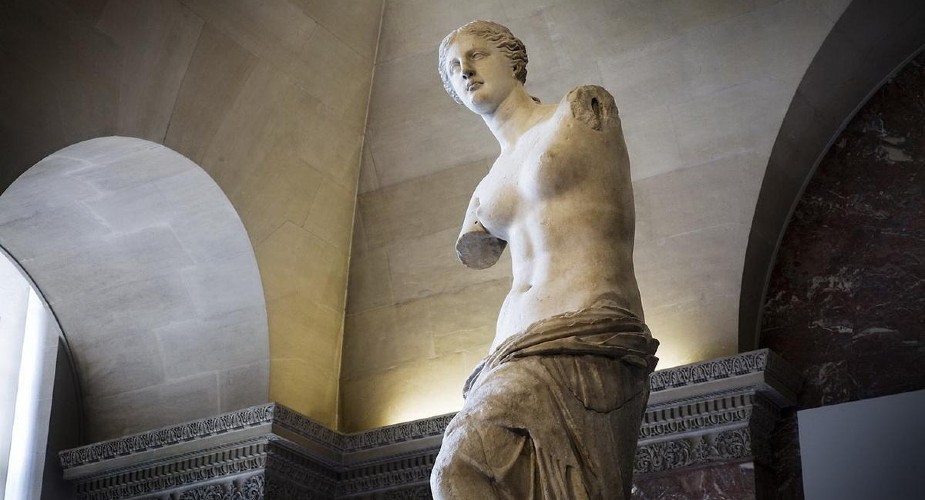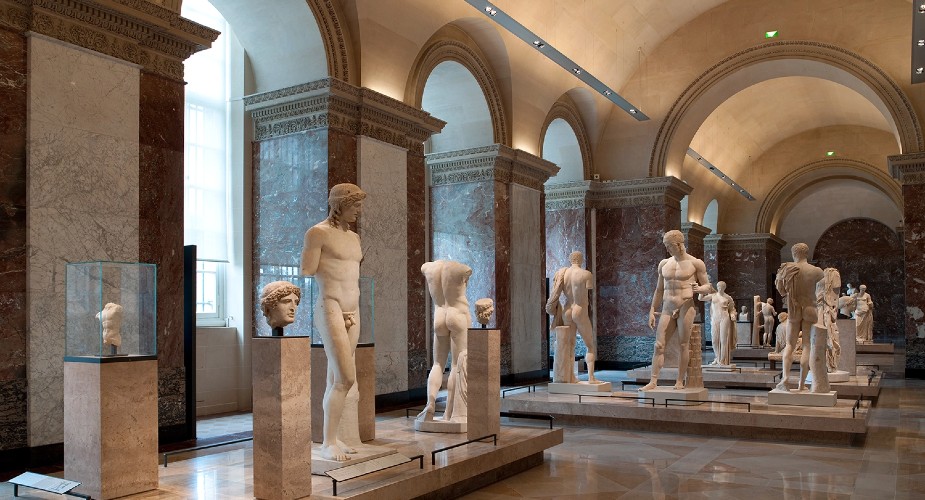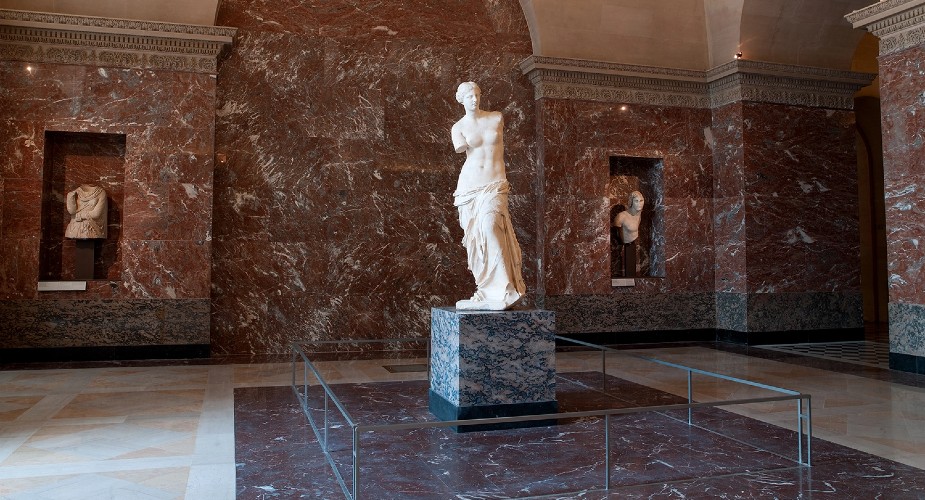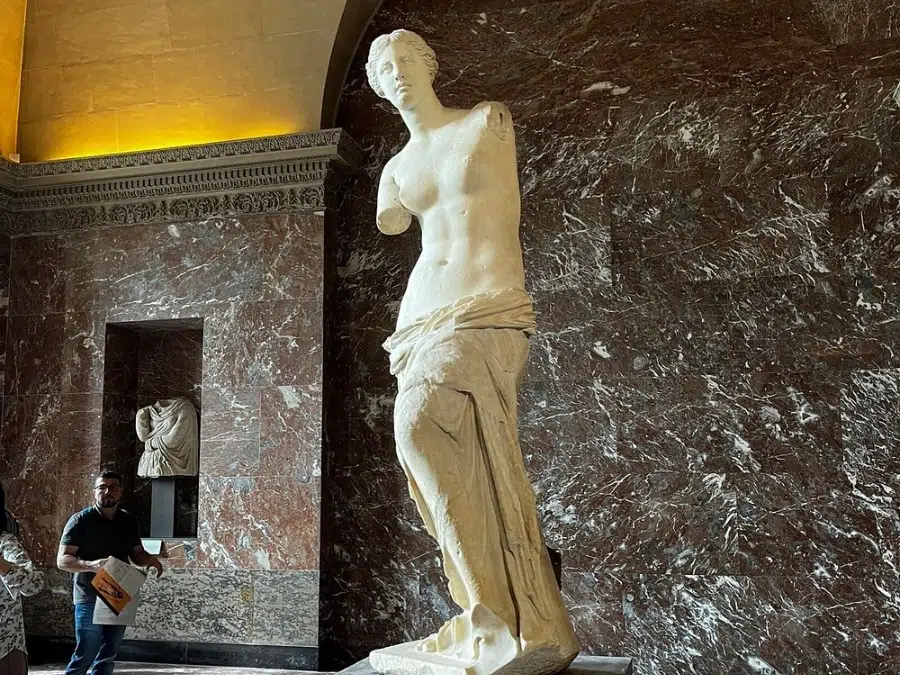One of the most iconic Greek Hellenistic sculptures in the Louvre Museum is the Venus de Milo statue! It was crafted around 150 BC, and even though it is damaged, its beauty and artistic brilliance capture the attention of all visitors to the Louvre. Visitors planning to see the stunning centuries-old Venus sculpture must know all about its location and the best time to explore the museum. In this article, we’ll discover the art techniques, backstory, interesting facts, and more about the sculpture so you can have the most informative experience possible!
Description of the Sculpture
The magnificent Venus de Milo sculpture, also called Aphrodite of Melos, depicts the Roman goddess Venus, Aphrodite in Greek mythology. It is 6 feet and 7 inches tall and made of white Parian marble. The woman’s torso is bare, with a cloth draped over the bottom half of her body, and is missing both arms, earlobes, and a left foot. Most of the statue’s weight falls on the right foot, while the left is paused in motion in the air.
Aphrodite’s head is turned to the left side and has small eyes, strong eyebrows, and a nose. Her lips are slightly parted, which gives the sculpture an idealized look, unlike the realistic proportions of the body. The right and front sides of the statue are carved more smoothly, while the left is rough, considering this part of the statue is hidden from view. The drapes and the garment Aphrodite is wearing at her hips are in the Hellenistic art style!
The Mythological Backstory of Aphrodite of Melos

As the sculpture does not have hands, it is challenging to uncover what actions Aphrodite was doing in the sculpture, but there are a few speculations. When the statue was discovered on the Island of Melos, a hand holding an apple was found close to it. The apple is one of the main reasons researchers believed the statue closely resembled Aphrodite.
There is an interesting backstory behind the statue if she was originally crafted with an apple in her hand. It follows the tale of the Trojan War when Prince Paris chose Aphrodite as the fairest of the Goddesses and handed her the Golden Apple. This event offended Hera and Athena and was also the main reason Helen was sent away to Sparta to become the Queen. You can see Aphrodite’s left hand holding the apple in the same room as the statue!
Louvre Venus de Milo Location: Which room is the statue in?

The statue stands in the Sully Wing, on the ground floor in Room 345. It is part of the Greek, Etruscan, and Roman Antiquities Departments. Room 345 has stunning brown marble walls that make the white sculptures stand out as the center of attention.
You can get to the Sully Wing from any entrance since there is no direct entry to the Sully Wing from the outside. Visitors will also spot some other antique 2nd-century statues in this Room and a Hellenistic period relief with Aphrodite’s portrait! You can also find other incomplete Greek statues inside this Room.
Best Time to Visit the Venus de Milo Sculpture

The best time to visit the Louvre on weekdays is from 9 am to 10 am and 3 pm to 5 pm. On weekends, you will only find fewer crowds in the rooms from 9 am to 10 am. The Sully Wing is open from 9 am to 6 pm on Mondays, Thursdays, and weekends. It is closed on Tuesdays. The Wing is open from 9 am to 8 pm on Wednesdays and Fridays.
The Louvre Museum’s Sully wing is not as crowded as the Denon Wing, which houses the most famous museum artworks. However, you might find the gallery slightly more crowded since the Aphrodite of Melos is one of the famous Louvre Museum artworks. We don’t recommend exploring the Sully Wing on the first Friday of every month since entry is free after 6 pm on this day. Check out our Best Time to Visit the Louvre Museum article to discover the best month to plan your trip to see the Venus de Milo statue.
Louvre Museum Tickets to see the sculpture
You must have Louvre Museum tickets to explore the Sully Wing and other Wings of the Louvre, except for the first Friday of the month when admission is free after 6 pm. The standard Louvre skip-the-line tickets with access to all parts of the Museum till closing hours cost €25 for visitors between 18 and 99 years of age.
History and art lovers looking to learn more about all the Hellenistic sculptures in the room would enjoy experiencing the Louvre Museum Guided Tour. This tour also covers the history of the Aphrodite of Melos’ statue, costing €84 for visitors between 18 and 99 years old for 2 hours. Kids 17 years and below can enjoy this guided experience for a discounted price of €69!
Louvre Museum secrets? You’re invited in!
Join millions of happy travelers by booking with our world-trusted partners.
Art Techniques Used in the Hellenistic Sculpture
Hellenistic sculptures are known for their realistic depictions, showing raw human emotions with expressive facial expressions. Women, children, and animals were always the main subjects of Hellenistic art. The artists like to sculpt nude figures standing in striking poses, wearing bare clothing material to show their hold over creating ornate designs to represent a cloth-like material. They wanted to invoke strong emotions amongst all viewers, so they focused on enhancing the subject’s character through fear, sleep, or old age. What makes Hellenistic art so special is that its depictions moved away from the idealized carving style from the Classical period. We recommend visiting the Winged Victory of Samothrace sculpture in the Denon Wing, which is also a marvellous piece of Hellenistic art!
History of the Sculpture

A Greek farmer was the first to find the Venus statue on the Island of Melos on 8th April 1820. While he dug out the sculpture on the land of the Ottoman Empire, a French sailor spotted him and encouraged him to keep going. Oliver Voutier, the sailor, and the farmer uncovered two pieces of the sculpture’s body, a left foot, and a third piece of the arm on the side.
Comte de Marcellus purchased this sculpture from a farmer and brought it to France as a gift for King Louis XVIII, who put it on display in the Louvre! The sculpture did not undergo any restorations, even though it was completely damaged and simply displayed as it was in 1821. It was temporarily placed beside Michelangelo’s prisoner sculptures but was moved to the Sully Wing to avoid overcrowding in one room.
Facts about Venus de Milo
Want to know more? Here are some mind-blowing facts about the Venus de Milo sculpture to surprise your friends and family with your art knowledge!
- Researchers believe the sculpture could also be of the Sea Goddess Amphitrite, who was worshipped in Melos.
- The sculpture gets its name from the Island of Melos, where it was found.
- No one knows what happened to Aphrodite’s arms in the statue.
- It was believed that Greek sculptor Praxiteles sculpted the statue since it looked so much like his other sculptures of Venus.
FAQs on Venus de Milo Louvre Museum
1. Why is the Venus de Milo sculpture so special?
The sculpture is so famous as it offers a glimpse of the Hellenistic art period! It is also well-known since there is no knowledge of its creator, actual origin, or year of construction.
2. Why is it called Venus de Milo and not Aphrodite?
Since the Greek Goddess Aphrodite was called Venus in the Roman Empire, the name is often used interchangeably. Hence it is called the Venus de Milo.
3. What happened to the statue’s arms?
There are rumors that the statue lost its arms during a fight on the Island of Melos in 1820, however, there is no evidence of this incident.
4. How much is the Venus de Milo worth?
The statue is worth around $5 million but is unavailable since the French Government owns it.
5. What is a fun fact about the statue?
The statue was believed to be carved by Greek sculptor Praxiteles since it resembled all his other Venus figurines.
6. What is missing from the Venus of Melos’ statue?
The statue is missing its arms, earlobes, and the left foot. However, you can see a supposed piece of Aphrodite’s left hand holding an apple, which was found right beside the statue in Room 345 of the Sully Wing.
7. When did the statue come to the Louvre Museum?
The statue came to the Louvre Museum in 1821 and was gifted to King Louis XVIII by Comte des Marcellus.
Featured : Image Canva




